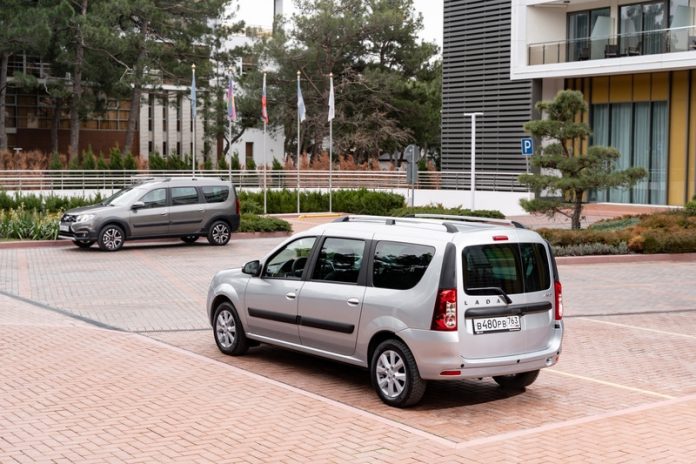A few years ago, the Logan model, which is sold in Eastern Europe under the Romanian brand Dacia, helped the Renault brand achieve success in Russia. We decided to sell the Logan MCV station wagon under the Lada brand. The car was equipped with VAZ engines and was named Largus. The unusual but practical form factor also helped Largus become a bestseller in Russia. In early spring, the popular model was updated and became much better.
Appearance
At the end of last year, the main ideologist of VAZ’s “X-design” Steve Mattin left AvtoVAZ, but the corporate style he created remained. The appearance laid down by Mattin in Xray and Vesta was first tested on Granta, now it’s the turn of Lada Largus.

Minimum transformations and Largus began to look much more solid and presentable in the X-design than its predecessor. In fact, the old Largus was pulled the muzzle from Vesta. The car received headlights from the second generation Logan, a new hood, bumper, radiator grille. The new model got mirrors with built-in turn signals from Lada Vesta.

The rear part remained completely unchanged, although the lights could have been extended to the roof, it would have looked better than simple black plastic trims. But, probably, here they decided to go the way of minimum costs for maximum external update from already existing components.

After restyling Largus received 267 new parts, 145 elements were previously used on other models of the Renault-Nissan-AvtoVAZ alliance. However, even skillfully applied parts from other models did not spoil Largus. It looks very good, especially in the off-road Cross configuration with black plastic body kits.

Interior
In the interior of the Lada Largus, if you look closely, you can also see elements from other models of the alliance. If earlier the instrument panel of Largus was from the first generation Logan, now it is from the first generation Renault Duster with a niche in the upper part. The Kalinovsky instrument cluster was replaced with a Logan one with chrome hoops, but the scales themselves were designed in an orange style, like on the Vesta and the restyled Granta.

The multifunctional heated steering wheel in the updated Largus was borrowed from the Xray/Vesta family, the door panels are from the Duster, the climate control unit is also from it, the gear lever is from the second Logan. The multimedia system with a seven-inch touch screen also migrated here from the previous Logan/Sandero/Duster, but now it supports Apple Carplay and Android Auto.

The window lift buttons were moved to the doors, and the seat and windshield heating buttons and a USB port appeared under the climate control unit. The cabin has become quieter due to improved sound insulation. And in the maximum configuration, the new Lada Largus will have a rear-view camera, heated windshield, heated front seats and second-row seats, cruise control, light and rain sensors.


The front seats received more developed lateral support, the crossover will have two-tone upholstery. For convenience, a small armrest with a niche was installed between the seats. The only element in the cabin that remained in its place is the control lever for electric mirror adjustment. It is under the “handbrake”, that is, it will not be possible to adjust the mirrors while driving.

Motors
Two engine options are available for the Lada Largus. The top one is a sixteen-valve gasoline unit with a capacity of 106 horsepower. It has remained unchanged. This engine has proven itself well in other Lada models, but if the same Vesta with such an engine shows good dynamics, then the Largus with it, frankly speaking, does not go. The eight-valve engine of the same volume now develops not 87, but 90 horsepower. At low revs, it is more powerful than the older engine. About 80% of the torque is available for it already at 1000 rpm. Also, on a 90-horsepower engine, there is no need to adjust the valves at a mileage of 90,000 kilometers, as was previously the case.
For commercial purposes, an eight-valve engine is better suited due to lower consumption, greater traction and tax legislation. In fact, after the update, Largus has become more profitable to operate. As for the suspension, it is indestructible, you can drive where there is no asphalt or it has strong potholes. In general, Largus would be just an ideal car for the countryside, hunting and fishing, if it had all-wheel drive and a diesel power unit.

Everything new is well forgotten old
Someone will ask why the changes in the new Largus are not radical. In 2021, the buyer is offered a Dacia Logan in the first generation station wagon body, but under the name of the new Lada Largus? This is a logical and economically correct decision not so much on the part of the Lada brand, but on the part of the entire Renault-Nissan-AvtoVAZ alliance. In a country where the middle class, according to our government, earns 17,000 rubles a month, such a car seems like a desirable purchase.
Its consumer values simplicity and functionality, practicality and low operating costs. Yes, it does not have leather seats or soft plastic in the cabin, but by modern standards, Largus is quite well packaged to confirm its status as a bestseller in its class. In fact, this is the only most affordable seven-seater car in the budget segment up to 1 million rubles and Lada Largus simply has no competitors.
The theme of the old Logan and the B0 platform will most likely continue to be used in Lada models as part of the Renaultion strategy, when Dacia and Lada become a single structural division. It would be stupid to kill the goose that lays the golden eggs. Perhaps, following the Logan MCV station wagon, we will see a Logan sedan in the Lada lineup, which in the future will turn into a new generation of Lada Granta.










